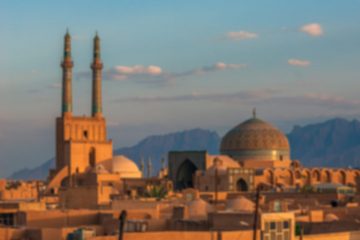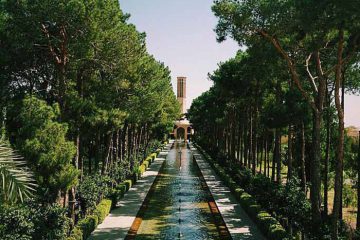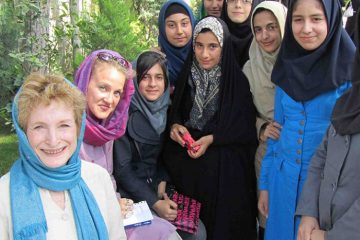Qanat | Iranians Found Water Below Desert!
Persian Qanat (or Kariz) is an ancient Persian invention of water supply system, which allowed permanent settlements and various civilizations in arid regions. So one might as well call it “Qanat Civilization” of about 3,000 years of antiquity! Persian qanat system taps into the ever-existing subterranean water, and channeling it to earth surface and providing drinking water and water for agriculture.

Outstanding universal value of Persian qanat led to its inscription as a UNESCO World Heritage in 2016. Qanat of Gonabad, in Khorasan Province, and Qanat of Zarch in Yazd Province are among the most laudable hallmarks of this technology.
#1 Construction of Qanat System
Qanat are constructed in the arid and semi arid regions of Iran. Starting location of Qanat is the foothills of mountains.

Aerial View of Well Shafts of Qanat (Photo Credit: UNESCO)
Each qanat comprises tunnels, kilometers long, directing water from an underground water source, into which a mother well is dug into the appropriate level of the aquifer. In order to dig the tunnels, well shafts are sunk at regular intervals along the route to also enable maintenance and allow ventilation.

The water is transported along gently sloping underground tunnels, by means of gravity to the outlet (Mazhar), from where it is distributed by channels to the agricultural lands and settlements for drinking purposes.
On its course through different layers of earth, water may become saline, which again was put to use in irrigation of orchards thriving on saline soil and water, such as pistachio orchards.
Qanat is constructed manually by a group of skilled laborers, called Muqannis. Identification of the appropriate water source, tunneling and maintenance of qanats required great mastery and rigorous effort.

Muqannis Removing Soil from Well Shafts
The value of a qanat is determined by the quality, volume and flow consistency of the water it delivers.
# Payab Is the Final Stop
For easy access of locals to water of qanat, stairways to below ground were built with notable portals (Payab) in the village or town, or more affluent residents had Payabs built below their houses. People would also go to Payabs to do their washing, or in hot summer days, they would seek cool and shelter, down the Payab.

Payab is the access corridor to water
#2 Astonishing Figures on Qanats of Iran
- A total length of 376,000 kilometers of qanat underground tunnels have been recorded across Iran. (Equatorial circumference of the Earth is 40,075 km, and average distance of the Earth from the Moon is 384,400 km)
- An average of 29,630 of branches and sub branches of qanats per province existed in Iran until 1951, according to findings of Dr. Taghi Bahrami, a prominent researcher of agricultural studies in 20th century Iran.
- Jean-Baptiste Chardin, the prominent western traveler (1643-1713), mentioned in his memoir that there were allegedly 42,000 branches of qanats in Khorasan region of Iran of the time (Safavid era).
#3 Two Grand Qanats in Iran
To better appreciate the grandeur of this ancient invention, let us look at two examples of Qanat in Iran:
- Qanat of Zarch in City Of Yazd, is the longest in the world, 100 km of tunnels, with a 90 m deep mother well, and more than a thousand well shafts along the routes.
- Qanat of Gonabad (Qasabeh) in Khorasan, is the oldest in the world, with estimated 2,700 years of antiquity. It stretches over 33 km, with the main mother well, about 365 meters deep.
Both qanats along with 9 other are inscribed as UNESCO World Heritage, which are still functioning and providing drinking and irrigation water supplies to their surrounding settlements.

Qasabeh Qanat in Gonabad
#4 Advantages of Qanat
Persian qanat prides itself as an ancient yet avant-garde technology, so much so that to this day, it is deemed an effective solution to water scarcity issues in Iran.
Here is a short list of advantages of qanat system:
- Qanats tap into abundant subterranean waters. Hence, dry seasons and low precipitation have minimal affect on their water supply.
- Although expensive to construct, the long-term benefits of qanat for the community and investors of qanat construction were substantial.
- From a sustainability perspective, qanats are powered only by gravity, resulting in low operation & maintenance costs, once built.

#5 The White Attire of Qanat Laborers
Where water is, there is life, there is purity and there is prosperity! Water holds a sacred place among Iranians since old times. Yet no one, better than desert people can appreciate the true value of water, when they have to excavate deep in the desert to reach this essence of life.
With this mental background, muqannis attend to digging qanats, dressed in white, lest they bring any impurity to immaculate waters underground.

What is more, muqannis risk their lives by going below ground for hours. Flooding, collapsing of tunnels during construction or restoration and breathlessness are all threats the muqannis knowingly take to deliver their duty. Hence, in a sense, wearing white, they are prepared for losing their life in this noble endeavor.
#6 Qanat Allowed Marvelous Developments
The advent of Qanat made possible development of permanent settlements and agriculture in the most arid regions. Not only that, various public facilities flourished through qanats, such as watermills, bathhouses, water reservoirs (Ab Anbar), Ice Houses (Yakhchal), caravanserais, etc. and most famously Persian Gardens in driest regions of Iran.

Shahzadeh Garden, Kerman – Persian Gardens in the arid regions owe their existence to qanats.
Shahzadeh (Shazdeh) Garden of Kerman is a fascinating example of Qanats coming to the aid of Iranians to create such prosperous oases in the desert.


